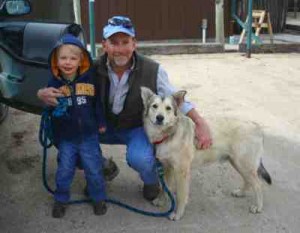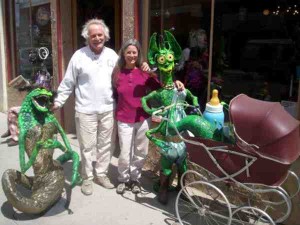Column by George Sibley
Economy – June 2008 – Colorado Central Magazine
LIKE EVERYWHERE ELSE IN America, we in the Upper Gunnison part of Central Colorado are concerned about the economy. We talk about the national economy, of course, but we talk about it the same way we talk about the spring weather — like it or not, it’s something we can’t do much about (although our comments and complaints affirm the solidarity of the trickled-upon). We talk about the local economy with more passion and less solidarity, and have at least the illusion that it is somehow “ours.”
In the Upper Gunnison, most of the talk revolves around our Big Three: One, a large development proposed for annexation just east of, and adjacent to, the City of Gunnison. Two, a proposed molybdenum mine upvalley in the Town of Crested Butte’s watershed. And three, an expansion of skiing for the Crested Butte Mountain Resort onto an adjacent hill in the same watershed.
I could spend this whole column discussing the pros and cons put forward for any one of these three proposals, but I am more intrigued and challenged by looking at all three together, and the fact that all three have been part of our discourse, off and on, for as many as three decades; yet they neither “happen” nor go away. All three represent “economic development,” which is something we all seem to agree we need, but we can’t agree that any of the Big Three are what we want economically.
So I’m more interested, I guess, in the politics of our local economy — our “political economy.” We tend to think of “political economies” in terms of nation-states, along the lines of “socialist” or “capitalist.” But anywhere certain economic ideas and structures are favored over other economic ideas and structures, there is a political economy at work. All such choices are political, even if you haven’t articulated the politics. And maybe the real evolutionary-revolutionary action in America’s political economy is happening, not on Wall Street where the game has become making money betting against the economy, or in Washington where our national bankruptcy is advertised in the daily issue of another billion dollars of debt, but down on the ground where we are being forced to become more aware of the politics of the basic economic problem: How are we going to produce the goods and services necessary for the community to survive?
Here in the Upper Gunnison, there was a time when the political economy was predicated on the political idea of local sufficiency — a community-level economy defined and limited entirely by the circle of people producing and distributing, from their immediate environment, all the goods and services necessary for their survival as a community. Those were the people we called Utes. There have also been individuals and small groups in the valley, from Gunnison founder Sylvester Richardson to people today who come here to go “off grid,” for whom that kind of Jeffersonian local sufficiency is the ideal political economy.
BUT FOR MOST OF US “moderns” in the valley, from the foundational days of the 19th-century silver boom to the present, the political economy of the valley has been based on the concept of “parting out” the valley to sell the valley’s assets to the larger world “Out There,” in order to obtain the goods and services from “Out There” that we need to survive here. A century ago, this valley was producing mostly coal and cows to trade for the goods and services we needed from elsewhere, which included food that arrived in tin cans, most of our clothing (especially “the latest Paris fashions” ), and most of our cultural ideas and imaginings which arrived in the form of newspapers and magazines (including the Sears Rowboat and Monkey Ward catalogs).
Today the goods and services traded between Here and There have changed. We still produce a lot of cows to trade Out There, but we are now “mining” other assets, like scenic homesites on which people from Out There build large, elaborate, and often empty houses. Mostly, though, we produce services rather than goods — chiefly catered vacations and educations.
Now we get even more of our food from Out There, which arrives “fresh” (ripening en route) or in flash-frozen packages as well as in cans; the clothing is more varied and even more “globalized,” and the cultural ideas and imaginings which divert our minds are packaged and sold to us through a much more sophisticated and diverse set of media.
But despite a different mix of products and services going each way, the basic political economy is unchanged: We trade the assets of the valley to Out There for the wherewithal to survive here. If anything, our dependency on Out There has increased significantly over the past century. A century ago, we produced most of our energy (including electricity) locally — from coal and wood — but today most of our energy comes from Out There in big trucks, pipes and transmission lines. We once had sawmills that converted trees from the valley into building materials, butcher shops and small-scale packers that converted cows into beef, and gardeners and potato growers who converted dirt into edible produce for local markets; but today almost all of that work happens Out There.
We are, however, more aware today of the inherent paradox built into this political economy. The quality of the vacations and educations we market depends on the natural beauty and still “open” nature of our valley, but there is a point beyond which our efforts to part out and peddle our assets will seriously diminish the valley’s attractiveness to outsiders.
SO MOST OF THE OUR DISCUSSION about the local political economy — which focuses today and perhaps forever on the “Big Three” — is what you might call “cake politics.” How much of our cake can we eat, and still have the essential cake? How much of the valley can we cover with houses and roads and ski lifts and mine tailings before the valley loses those “natural” and “open” qualities which bring people here for vacations and educations?
There is obviously a lot of subjectivity and self-contradiction in this. Some of the people who oppose the expansion of the ski area came here in part because there was already a ski area here. Almost all of us have “lifestyles” that depend heavily on the mining of assets from mountains and valleys somewhere. And you can bet that, when today’s newcomer arrives in the valley thinking he or she has discovered paradise, someone else will be leaving in disgust, proclaiming the place ruined forever.
There are also discernible “economic classes” in our local political economy — not the usual division into “haves” and “have-nots,” but a class division based on where one’s money comes from. A lot of us here — college faculty and staff, state and federal employees, the growing number of retirees and “trustfunders” — get our incomes from Out There. The rest of us have to generate incomes through the local production goods and services to trade Out There. Again, this is not a “wealth” division; some of the second group are doing better than some of the former group. But there is a fairly predictable division of opinion between those two economic classes over how much of the valley we need to utilize in order to eat, and how much of it we can afford to keep “pristine.”
PEOPLE CAN ONLY WORK through such political dilemmas around points of common agreement, and there does seem to be general agreement in the valley that “the fate of the cake” is a very real challenge. We continue to hash this out in public discourse, and we have passed — with widely varying degrees of enthusiasm and reluctance — master plans and a big land use resolution that attempt to slow and concentrate the sprawl of the “eaten cake” out into the “cake we have left.”
But when it comes down to making political decisions about any one of our “Big Three” economic propositions, we seem unable to say, okay, let’s put it to the test of our master plan: If it can’t be made to fit the criteria of the master plan or the LUR, then it can’t happen. Instead, we fall back on the “over my dead body,” “my way or the highway” polarizing passions that defy resolution.
All of which is to say — what? When I look at the things rolling down out of the immediate future — the emerging uncertainties of climate change, the imminent loss forever of cheap and easy energy, the dawning consequences of being the world’s largest debtor nation, et cetera — our fixation on our “Big Three” begins to look like the same sort of “fiddling while Rome burns” blunder that now defines the national political economy. And the economic and political forces Out There, which are massively into denial about those even larger economic and political forces bearing down on us all, would undoubtedly rather see us fighting among ourselves over how much of us they get to consume, than see us getting seriously collaborative about better ways to locally produce and distribute the goods and services we need in order to survive here.
George Sibley writes from Gunnison, where he was summoned from retirement to run the Colorado Water Workshop this year.


